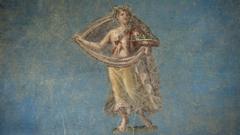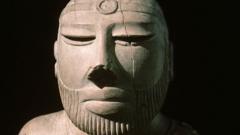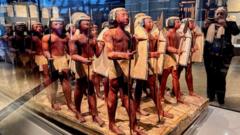Recent excavations at the ancient site of Pañamarca have unveiled a beautifully adorned throne room, along with an intricately designed “Hall of the Braided Serpents," suggesting the presence of a reigning female ruler in the Moche culture. This finding challenges the long-standing notions that this civilization was solely dominated by male figures.
**Ancient Ruler Unearthed: Insights from the Moche Culture of Peru**

**Ancient Ruler Unearthed: Insights from the Moche Culture of Peru**
Archaeological discoveries in Peru reveal the powerful role of a woman in the Moche civilization over 1,300 years ago.
In a groundbreaking exploration, archaeologists have uncovered monumental chambers, richly embellished with murals depicting serpents and a worn throne, indicating that a woman may have been in power during the Moche society's peak. Flourishing in northern Peru long before the rise of the Inca, the Moche culture was known for its impressive constructions and advanced agricultural practices.
The findings, detailed in a report from researchers last month, enhance our understanding of Moche ceremonial practices and mythology. Noted archaeologist Gabriela Cervantes Quequezana stresses the significance of this discovery, highlighting it as a rare representation of a woman in a position of authority, contrasting with previous depictions often focused on male warriors.
The throne room's decor includes paintings of a crowned woman, seated on a throne, receiving visitors alongside symbols of authority such as the crescent moon and sea creatures. The throne, dated to around A.D. 650, displays wear that suggests frequent use. Lisa Trever, an art history and archaeology professor at Columbia University, confirmed the distinct significance of the find, emphasizing that the throne was likely intended for a queen.
This discovery not only sheds light on the complexities of the Moche civilization but also highlights the evolving recognition of women's roles in ancient societies. The ongoing excavation at Pañamarca is poised to further enrich the narrative of female empowerment within historical contexts traditionally dominated by male figures.
The findings, detailed in a report from researchers last month, enhance our understanding of Moche ceremonial practices and mythology. Noted archaeologist Gabriela Cervantes Quequezana stresses the significance of this discovery, highlighting it as a rare representation of a woman in a position of authority, contrasting with previous depictions often focused on male warriors.
The throne room's decor includes paintings of a crowned woman, seated on a throne, receiving visitors alongside symbols of authority such as the crescent moon and sea creatures. The throne, dated to around A.D. 650, displays wear that suggests frequent use. Lisa Trever, an art history and archaeology professor at Columbia University, confirmed the distinct significance of the find, emphasizing that the throne was likely intended for a queen.
This discovery not only sheds light on the complexities of the Moche civilization but also highlights the evolving recognition of women's roles in ancient societies. The ongoing excavation at Pañamarca is poised to further enrich the narrative of female empowerment within historical contexts traditionally dominated by male figures.
















